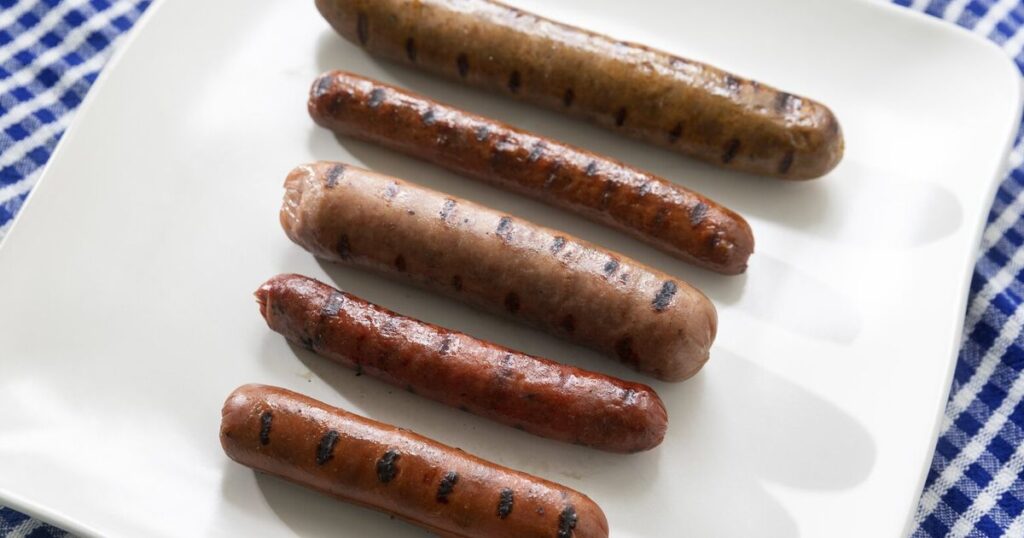Should you eat, or avoid, nitrates? It depends on where they come from

On Nutrition
If you’ve heard that nitrates are good for you, but also heard that you should look for the words “nitrate free” when shopping for hot dogs or bacon, and thought, “What the heck?” you’re not alone. The short explanation is that nitrates can either be beneficial or harmful, depending on where they come from and what they turn into — I’ve even seen them described as the Dr. Jekyll and Mr. Hyde of human health. Now let’s explore the longer explanation.
Nitrates are compounds made up of nitrogen and oxygen, and they first reached public consciousness when health experts started warning about their presence in processed meats. Manufacturers often add sodium nitrate or potassium nitrate to processed meats — including the aforementioned hot dogs and bacon, as well as, ham, sausage, pepperoni, beef jerky and deli meats/cold cuts — to preserve quality and prevent spoilage.
Here’s the bad news about that. Nitrates can turn into nitrites, which when exposed to high heat, can combine with the amino acids in the meat’s protein to form nitrosamides. These new compounds may increase the risk of certain cancers, especially those of the stomach and colon. This is one reason why a 2015 World Health Organization report deemed processed meat as probably carcinogenic to humans, stating that each 50-gram portion of processed meat eaten daily — about four slices of bacon or one hot dog — increases the lifetime risk of colon cancer by 18%. (To put that in perspective, that’s an additional 18% of what your risk would already be. If you have a 3% risk based on genetics or other factors, then your risk would become 3.54%.)
Now for the good news. We also find nitrates in plant foods, especially leafy vegetables, radishes, beets, celery and garlic. When you eat these plant-based nitrates, your body converts them to nitric oxide, which research shows can help protect against cardiovascular disease and other chronic diseases. A few helpful things nitric oxide can do is help regulate blood pressure and improve blood circulation. Nitrates from plants may also improve physical performance, especially during high-intensity exercise, which is why some athletes use beets or beet juice.
Of course, there are many additional benefits of eating enough nutrient-rich vegetables — something most Americans don’t do. In addition to vitamins and minerals, plants are rich in phytochemicals, some of which have anti-inflammatory benefits. Inflammation is one factor in cardiovascular disease, cancer and other chronic health conditions. Vegetables are also rich in vitamin C and other antioxidants, which can help offset the potentially negative effects of processed meats when eaten in the same meal. This is one reason why some manufacturers have started to add vitamin C to cured meats.
In case you’re wondering if cooking vegetables can turn their nitrates into nitrosamines, the answer is “not really.” Vegetables contain vitamin C and minimal protein, and we tend to cook them at lower temperatures than we do meat. Cooking processed meats at lower temperatures might slightly reduce nitrosamine formation, but the best bet is to limit intake altogether — and that goes for “natural,” “uncured” or “nitrate-free” versions, too.
These products are often manufactured using celery juice, celery powder or another natural source of nitrates. Even though celery doesn’t count as an “added” nitrate, these “natural” processed meats still contain nitrate — sometimes more than conventional processed meats — and can still produce nitrosamines. So when shopping for nitrate-free bacon, for example, check the label to make sure it doesn’t contain sodium nitrate, sodium nitrite, potassium nitrate or potassium nitrite, and that it doesn’t contain celery salt, juice or powder. Keep in mind that processed meats that are low in nitrates may have a shorter refrigerated life, so freeze what you won’t use quickly to preserve it longer.
Beets & greens farro salad with walnuts and feta
Serves 6-8
This nitrate- and fiber-rich salad makes a satisfying lunch, side dish or light dinner. If you want to increase the protein, stir in a rinsed, drained can of chickpeas or white beans, or top with some leftover cooked chicken or salmon.
- 2-4 beets (depending on size), roasted (see notes) and cut into bite-size cubes or slices
- 1 cup uncooked farro, rinsed (see notes)
- ½ cup olive oil
- 2 tablespoons sherry vinegar
- 1 teaspoon balsamic vinegar
- 1 teaspoon Dijon mustard
- 1 small garlic clove, minced
- ½ teaspoon salt
- 3 cups torn kale leaves (in bite-size pieces)
- 1/2 cup walnuts, toasted and roughly chopped
- ½ cup crumbled feta cheese
- ¼ cup chopped Italian parsley
- Cook farro according to package directions. (If no directions, place farro, 2 cups water and a pinch of salt into a saucepan. Bring to a boil, reduce heat to a simmer, cover and continue to simmer until the grains are tender but still chewy. This may take 20-40 minutes, so start testing after 20 minutes.) Remove from heat and allow to sit for 10 minutes.
- While the farro is simmering, combine the olive oil, vinegars, mustard, garlic and salt in a large bowl and whisk to combine.
- Add the warm farro to the bowl and stir to combine with the dressing. Add the shredded/torn kale and stir again to combine. Add the beets, walnuts, feta and parsley. Stir again and taste, adding more salt if needed.
Notes: To roast beets, preheat oven to 350 degrees F. Trim leaves and roots from the beets and place them in a covered dish with 2 tablespoons water. Roast for 1 hour (for smaller beets) or longer until tender. Remove and allow to cool until they can be handled. If you can’t eat gluten, trade the farro for a gluten-free grain. Short-grain brown rice or whole grain sorghum would be my picks.
should-you-eat-or-avoid-nitrates-it-depends-on-where-they-come-from



.png?width=1200&height=630&fit=crop&enable=upscale&auto=webp)


